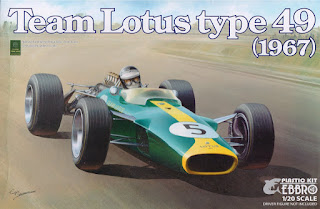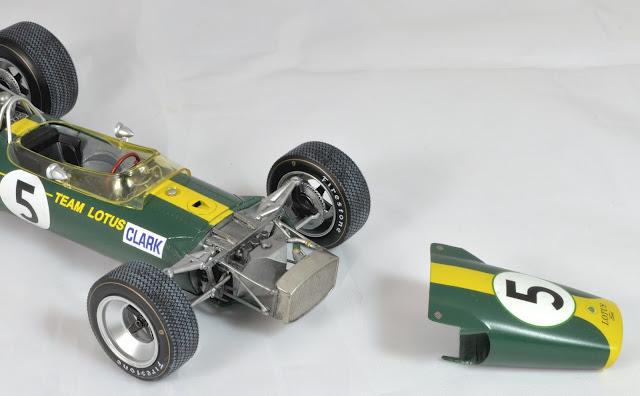Having been persuaded to branch out into Motorsport, I decided to start with an old classic. The Lotus 49 needs no introduction to those who know the subject, put together for the 1967 F1 season and utilising the ground breaking Cosworth DFV engine which went on to dominate the sport for many years.
One of the ironies of this particular project is that the person who helped me choose this subject matter was none other than William Hewland, a very good friend of mine who inherited Hewland Engineering from his father Mike. Legendary in their own right in Motorsport, Hewland provided the gearbox for the Lotus 49B but unfortunately not the original version which is the subject of this build. Sorry mate!
 Anyhow, on to the kit.It is exquisitely moulded, clean and crisp and fits together beautifully, with the possible exception of the nose cowling which really does not want to sit well. The sprues are pre-coloured in the style of the early Matchbox kits, although for a serious modeller this is irrelevant. One of the sprues is pre-coated in the familiar chrome finish so beloved of racing car kit makers, but not of modellers. A quick bath in bleach soon got rid of that. A set of brilliantly moulded and pre-painted rubber tyres is also included.
Anyhow, on to the kit.It is exquisitely moulded, clean and crisp and fits together beautifully, with the possible exception of the nose cowling which really does not want to sit well. The sprues are pre-coloured in the style of the early Matchbox kits, although for a serious modeller this is irrelevant. One of the sprues is pre-coated in the familiar chrome finish so beloved of racing car kit makers, but not of modellers. A quick bath in bleach soon got rid of that. A set of brilliantly moulded and pre-painted rubber tyres is also included.The instructions are excellently printed and intuitive, given the fact that to all intents and purposes this can be considered a Tamiya kit, the similarities should be no surprise. Included is a table of 1967 F1 GP events and the various options for decals, drivers and other car modifications are clearly represented. As far as I have been able to ascertain, all perfectly accurate as well. I chose Jim Clark's victorious car from the 1967 British Grand Prix, if only because I'm a Brit myself.
 As said, the kit goes together really nicely in the main. Putting the plastic together is relatively easy. What of course is harder is getting the painting and finishing right. I used various shades of A.K. Interactive XTreme Metal on the metalwork and this worked really well IMHO. The drivers tub is fairly basic, and I added a couple of details in there (such as the gearstick hole surround) myself from spare photo etch. Incidentally, the instructions call for the tub to be painted grey, however there is a little doubt about this. It is pretty certain that the original would have been bare metal if only to save weight. Preserved examples are painted grey and this is probably where the kit makers got their data from.
As said, the kit goes together really nicely in the main. Putting the plastic together is relatively easy. What of course is harder is getting the painting and finishing right. I used various shades of A.K. Interactive XTreme Metal on the metalwork and this worked really well IMHO. The drivers tub is fairly basic, and I added a couple of details in there (such as the gearstick hole surround) myself from spare photo etch. Incidentally, the instructions call for the tub to be painted grey, however there is a little doubt about this. It is pretty certain that the original would have been bare metal if only to save weight. Preserved examples are painted grey and this is probably where the kit makers got their data from. The engine and gearbox are nicely detailed, but as ever, there is almost endless scope for the super detailer to go mad. In the event, my main addition was some amount of cabling based on photo references. Some of the linkages are a little fiddly to install but the end result is well worth it.
The engine and gearbox are nicely detailed, but as ever, there is almost endless scope for the super detailer to go mad. In the event, my main addition was some amount of cabling based on photo references. Some of the linkages are a little fiddly to install but the end result is well worth it.My only real problem was fitting the front cowling in such a way that it sat flush but still could be removed to view the steering and radiator mechanism. This was not easy, the parts do not seem to want to mate up well and it took a lot of fettling to get a reasonable result.
Bodywork paint finish involved much use of micromesh and repeated gloss coats, it's not something I usually have to worry about too much with beaten up old war planes but here it is important to get it looking smooth. Once the decals had been applied I finished the whole thing off with a coat of semi-matt lacquer. A full gloss coat in this scale just makes it look like a Dinky toy.
A quick tarmac diorama base finished things of nicely as well.
But all in all, a fascinating exercise for me and I look forward to doing many more in the future. I hope you enjoy the photos!
















No comments:
Post a Comment